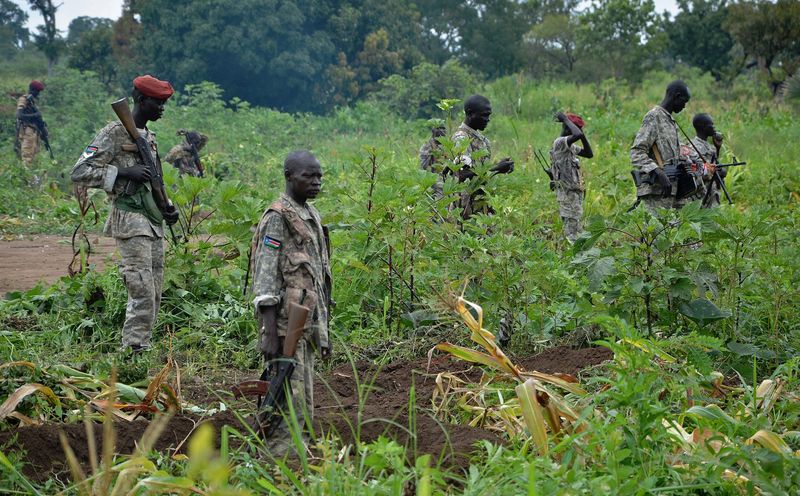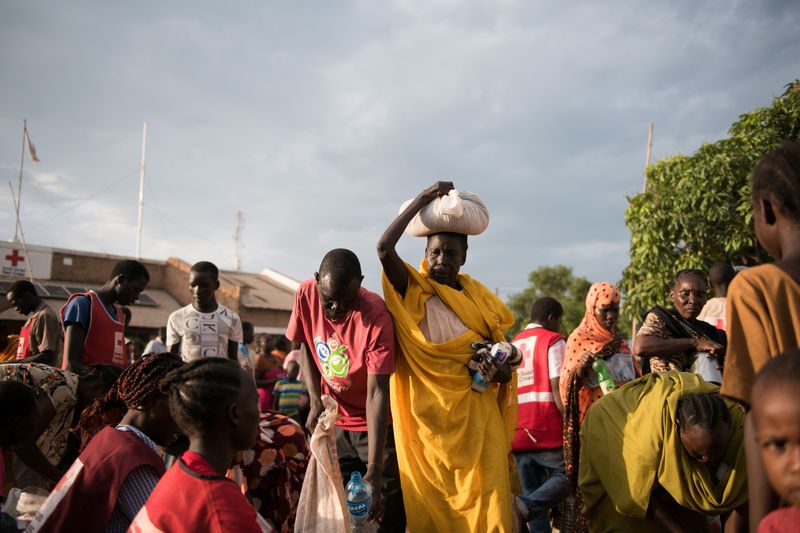
South Sudanese SPLA soldiers are pictured in Pageri in Eastern Equatoria. Photographer: Samir Bol/AFP via Getty Images
Each time Patrick Okello goes to tend his crops, he has to tell the soldiers or face 50 lashes with a whip when he returns.
They’re “always watching and very suspicious,” said the 43-year-old who grows cassava and corn on the outskirts of Pajok, his hometown in South Sudan’s Greater Equatoria region. This vast and now sparsely populated southern territory has become a major theater in the four-year civil war, with government forces accused of killing villagers, burning their homes and stealing food as they pursue rebels. The army denies the charges.
Maintaining his farm isn’t just about Okello’s survival. Equatoria was once South Sudan’s breadbasket, producing the corn, sorghum and vegetables that fed the nation including the oil-rich north where famine hit last year. Since fighting spread to Equatoria in mid-2016, output has collapsed, adding to what charity Oxfam International says is the likelihood of the country’s worst-ever hunger this year. The conflict that began in December 2013 has claimed tens of thousands of lives.
“Fighting and insecurity in Greater Equatoria means that food production is dropping every year,” said Ranjan Poudyal, Oxfam’s South Sudan director. “Farmers who have managed to stay are only able to cultivate land around their homesteads for fear that lands further afield are too great a risk.” That contributed to unprecedented hunger even during the recent harvest season, normally the most plentiful period.
Ghost Towns
Former residents describe many of Equatoria’s settlements as ghost towns, with buildings stripped of their iron roofing, doors and windows by looters; all that remain of some villages are burnt ruins. Civilians have fled to neighboring Uganda and the Democratic Republic of Congo, raising the number crossing borders to escape South Sudan’s war to 2 million and exacerbating what the United Nations in March called the world’s fastest-growing refugee crisis.
Aid groups have appealed for $1.72 billion to fund operations countrywide this year. An estimated 5.1 million people — almost half the population — are expected to face acute food shortages in the first quarter as insecurity limits access to farms and markets.
In Equatoria, as elsewhere, non-combatants are bearing the brunt of the violence. Government forces routinely respond to rebel ambushes with “unlawful reprisals against civilians who live in rebel areas and share their ethnicity,” New York-based Human Rights Watch said in August. It reported a “climate of fear” and tactics including arbitrary arrests, torture and restricting movement between towns and villages.

Food as Weapon
Amnesty International in July said both government forces and rebels have used hunger as a weapon of war in Equatoria, cutting supplies, looting from markets and homes and targeting civilians for perceived allegiances.
The war may not end anytime soon. East African nations in December convened new talks between President Salva Kiir’s government, the main rebel group led by his former deputy, Riek Machar, and several other armed factions, including from Equatoria. A previous peace deal led to a transitional government in 2016 that quickly collapsed, spurring greater violence. A cease-fire that began Dec. 24 was broken just hours later, and fighting has continued across the country.
Joseph Nangi, a 36-year-old father of four, is trying to ward off hunger in Yambio, the capital of one of Equatoria’s nine states. Yet he’s sheltering just a half-day’s walk from his crops, which he had to abandon when fighting engulfed his village in December 2016.
Speaking by phone, he described the risk of being killed or abducted if he returns. “Our crops are being eaten by wild animals and looted by armed men,” he said.

